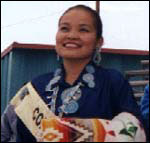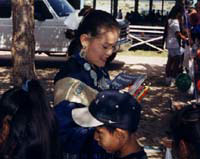Outfitted in moccasins and traditional dresses, the four contestants in the 49th Miss Navajo Nation Pageant — held this past September in Window Rock, Ariz. — demonstrated a dazzling array of cultural skills. They discussed, in Navajo, the Treaty of 1868. They carded and spun wool, and they displayed rugs they had woven. They prepared fry bread from scratch over an open fire of their own making. Just about the only things the contestants didn’t do were to butcher sheep (that popular event was cancelled this year) and to exhibit their bodies in bikinis and evening gowns.

Karletta Chief, bright as a
Christmas light.
Photo: Lisa Jones.
During the pageant, Karletta Chief — 24 years old, 4 feet 10 inches tall — displayed two expressions: the first as bright as a Christmas tree light, the other as grave as a visiting empress from Japan. She may very well have been reflecting on the extraordinary path that brought her to this most unusual beauty pageant — and that would lead to her crowning as Miss Navajo Nation 2000-2001.
A Dorm Room of One’s Own
Growing up in a one-room house with five siblings, a Baptist minister father, and a mother who sold homemade mutton stew and fry bread to jewelry vendors along the highway, Chief learned to work hard.
“I had to gather wood for the fire,” she says. “I had to walk to the pump to get a bucket of water. I remember how heavy it was.”
Chief applied this hard-working discipline to other parts of her life. “She taught herself the piano,” says her mother. “She taught herself the violin, too.”

Miss Navajo works the crowd.
Photo: Lisa Jones.
When she was five, Chief learned a different kind of lesson, in a year she spent living with her grandmother. “My grandma lives about three miles from a [Peabody Coal Company] coal mine,” she says. “She had to move several times because they leased their land from the mine. Grandma didn’t really have a say. One time, during a mining explosion, her corral caught on fire. So I was exposed to a lot of environmental injustice in my family. And they couldn’t do anything about it because they weren’t educated.”
Determined to do something about the situation herself, Chief focused on her school work. At Page High School, in Page, Ariz., a counselor encouraged her to apply to Stanford University. “I didn’t think I’d get in,” she says, but the university accepted her.
As might be expected, Chief’s adjustment to college life was far from simple. “Going was a really big culture shock. I’d had a very traditional upbringing on the reservation. Now I was exposed to really affluent people. Now I had everything: Running water, electricity. I had food. Lots of it.
“Stanford was really hard. First quarter I almost dropped out. I couldn’t talk to my parents because they didn’t have a phone. But by senior year, I was able to be happy there. When I first went there, there wasn’t anybody from the reservation. By the time I was a senior there were students from here.”
There’s No Place Like Home
Today, Chief is a doctoral candidate in environmental engineering and science at Stanford. She focused her master’s research on the effects of uranium mining on water quality on her Arizona reservation.
After completing her doctorate, Chief plans to return to the reservation to start an environmental consulting firm with her brother, an electrical engineer, and her cousin, a biologist. In the meantime, during her tenure as Miss Navajo Nation, Chief will take time off from her studies to advocate for environmental causes from a Navajo perspective.
“At Stanford, the city is really polluted,” Chief told the Navajo Times after winning the Miss Navajo Nation crown. “For us, we are so far more advanced in taking care of our land. As Navajos, our culture is tied to the land and if we don’t take care of our land and don’t instill that in our children, we’ll be the same as those cities.”
Karletta Chief will work hard as Miss Navajo Nation, and it’s likely that she’ll succeed in working with Navajo communities to advocate for environmental causes. One thing: Karletta Chief will set a high bar for the winner of that other beauty pageant.

